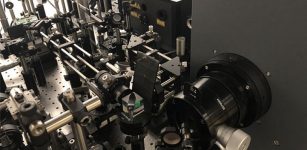New Laser Technology Could Solve The World’s Plastic Problem
Eddie Gonzales Jr. – MessageToEagle.com – Plastic pollution is a major global environmental issue, with millions of tons of waste accumulating in landfills and oceans each year.
Texas-led international researchers have developed a groundbreaking materials science method. They use lasers and 2D substances to break down molecules in plastics and other materials into reusable basic components.

Mirrors and prisms deflect lasers and focus them to perform the reaction. Credit: The University of Texas at Austin
Plastic pollution is a major global environmental issue, with millions of tons of waste accumulating in landfills and oceans each year.
Texas-led international researchers have developed a groundbreaking materials science method. They use lasers and 2D substances to break down molecules in plastics and other materials into reusable basic components.
This innovative approach offers a solution for hard-to-recycle plastics, enhancing waste management practices. The discovery could revolutionize material decomposition and recycling across industries, promoting more efficient and eco-friendly material management.
“These reactions allow us to convert environmental pollutants into valuable, reusable chemicals, supporting a more sustainable and circular economy,” according to Yuebing Zheng, professor in the Cockrell School of Engineering and project co-leader.
This discovery significantly impacts environmental solutions and green chemistry advancements.
Researchers used low-power light to transform plastics into luminescent carbon dots by breaking and reforming chemical bonds. These carbon-based nanomaterials, highly valued for their versatility, could potentially serve as memory storage in future computer devices.
“It’s exciting to turn potentially non-degradable plastic into something useful for various industries,” said Jingang Li, a UC Berkeley postdoc who began the research at UT.
The reaction, called C-H activation, breaks carbon-hydrogen bonds in organic molecules to form new chemical bonds.
In this study, two-dimensional materials catalyzed the reaction, transforming hydrogen into gas. This allowed carbon molecules to bond, creating information-storing dots.
Further research and development are needed to optimize the light-driven C-H activation process and scale it up for industrial applications. However, this study represents a significant step forward in the quest for sustainable solutions to plastic waste management.
The light-driven C-H activation process demonstrated in this study can be applied to many long-chain organic compounds, including polyethylene and surfactants commonly used in nanomaterials systems.
The study was published in Nature Communications
Written by Eddie Gonzales Jr. – MessageToEagle.com Staff Writer










